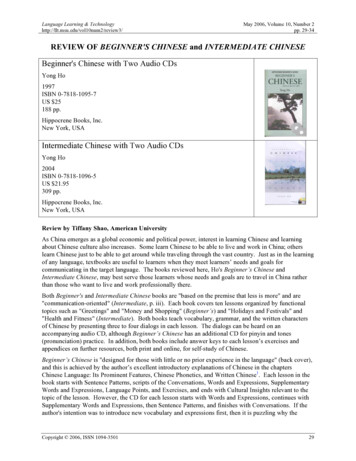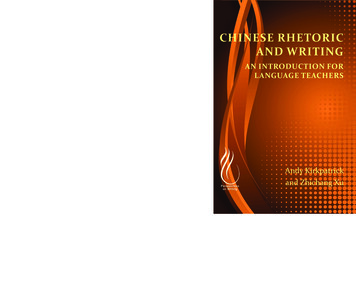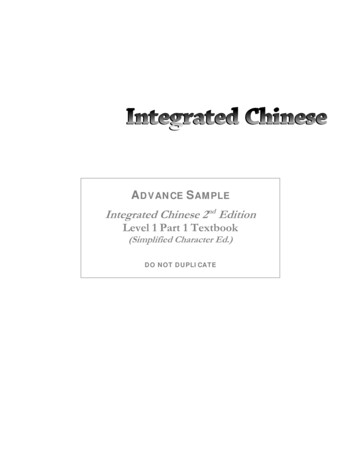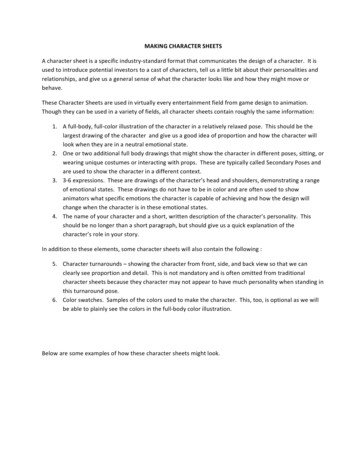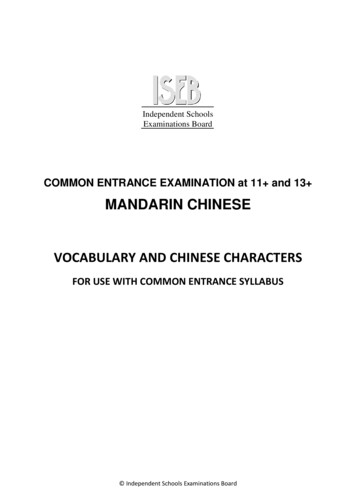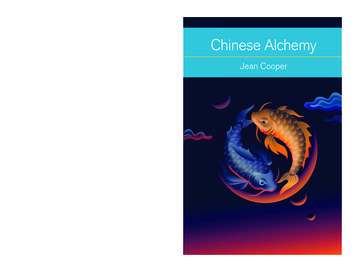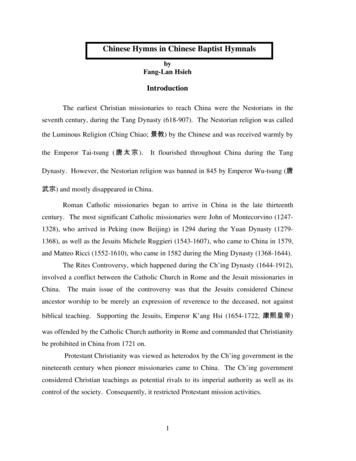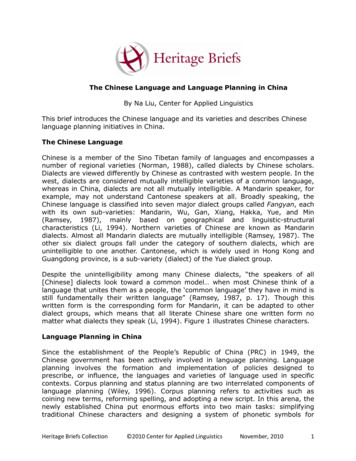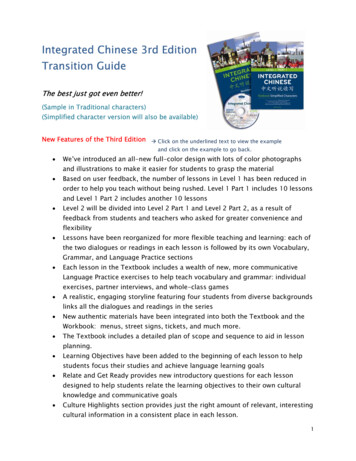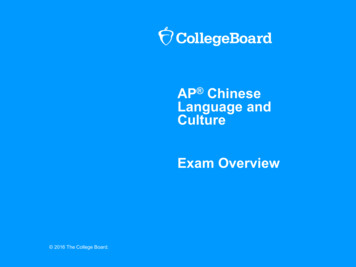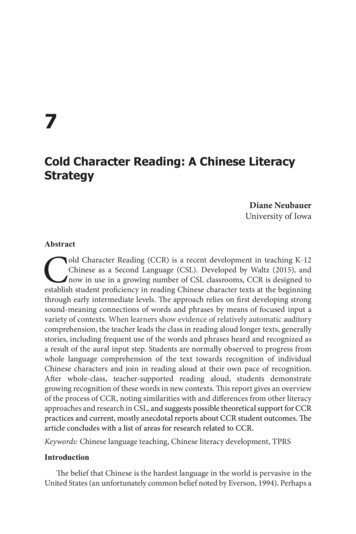
Transcription
7Cold Character Reading: A Chinese LiteracyStrategyDiane NeubauerUniversity of IowaAbstractCold Character Reading (CCR) is a recent development in teaching K-12Chinese as a Second Language (CSL). Developed by Waltz (2015), andnow in use in a growing number of CSL classrooms, CCR is designed toestablish student proficiency in reading Chinese character texts at the beginningthrough early intermediate levels. The approach relies on first developing strongsound-meaning connections of words and phrases by means of focused input avariety of contexts. When learners show evidence of relatively automatic auditorycomprehension, the teacher leads the class in reading aloud longer texts, generallystories, including frequent use of the words and phrases heard and recognized asa result of the aural input step. Students are normally observed to progress fromwhole language comprehension of the text towards recognition of individualChinese characters and join in reading aloud at their own pace of recognition.After whole-class, teacher-supported reading aloud, students demonstrategrowing recognition of these words in new contexts. This report gives an overviewof the process of CCR, noting similarities with and differences from other literacyapproaches and research in CSL, and suggests possible theoretical support for CCRpractices and current, mostly anecdotal reports about CCR student outcomes. Thearticle concludes with a list of areas for research related to CCR.Keywords: Chinese language teaching, Chinese literacy development, TPRSIntroductionThe belief that Chinese is the hardest language in the world is pervasive in theUnited States (an unfortunately common belief noted by Everson, 1994). Perhaps a
138The Power of Language, The Power of People: Celebrating 50 Yearsmore accurate way to describe the situation is that the linguistic distance betweenEnglish and Chinese is greater than that between English and languages withmany cognates, and so there is less transfer from L1 English to L2 Chinese thanto languages with many cognates shared with English. Since Chinese does not usethe same Roman alphabet in its character script, reading Chinese character textsrequires more instructional time to reach advanced levels of literacy. According toJackson and Malone (2009), Chinese is among several languages expected to takeState Department employees two full years in very intensive language study, aboutfour times as long as for Western European languages (cited in Everson, 2011).Learning to read Chinese character texts is a key aspect of the challenge ofChinese language learning for those whose first language is English (Hayden,2007). Referring to languages with writing systems other than the Roman alphabet,Everson (2011) notes,If these languages are ever to take their place as more commonly taughtlanguages in world languages education, it will be essential that wecome to understand how these languages are mastered by students ofdifferent ages, who come from different literacy backgrounds, andwho learn them in a variety of different learning settings. (p. 250)However, how most effectively to address the needs of different learners as theybegin to read Chinese texts has not yet reached consensus (Everson, 2011). Manyinstructors use character- and word-recognition activities as the basis for earlyliteracy development, perhaps due to the importance of word recognition in textlevel comprehension (Grabe, 2009). Students are expected to recognize words inisolation before attempting longer character texts. By contrast, Cold CharacterReading (CCR) builds on aural comprehension of carefully designed discourselength texts and strategic teacher support as a way for beginning readers of L2Chinese to gain reading ability quickly. Single word recognition develops moreimplicitly, it is suggested, as a result of that process. CCR is a recently-developedclassroom literacy strategy designed to make the reading of Chinese character textsmore accessible by fast-tracking initial, functional reading ability for beginninglevel readers of L2 Chinese.Contemporary CSL literacy practices and researchThere are some areas of difference and some areas of similarity between CCRand other literacy approaches. Very little current research has yet been applied toCCR due to its recent introduction in CSL. Let us first consider current scholarshipin Chinese reading to inform our evaluation of CCR.Everson (1994, 2016) has suggested a process-oriented approach to Chineseliteracy. Rather than asking students to learn new words, their pinyin (Romanized,phonetic) spelling, and character forms all at once, he recommends first allowingstudents to read in pinyin, introducing the same language in characters withoutpinyin later. He also recommends allowing novice learners to learn Chinesecharacters as whole characters rather than stressing memory of charactercomponents, whether phonetic or semantic, finding that intermediate and
Cold Character Reading: A Chinese Literary Strategy 139advanced students naturally develop component recognition. Packard (1990)found similar principles seemed to benefit college-aged beginning learners ofChinese. While research findings about benefits from delaying characters hasrecently been challenged by a study among middle school learners (Knell & West,2017), Shen (2014) suggests that research evidence is strongly in favor of delayingcharacters. She observed, “[w]ith strongly developed phonological skills, studentswho come to the Chinese reading task will not have to dwell excessively on thegraphic features of the characters” (p. 278).Shen (2005, 2013) indicated that, for Chinese, comprehension of 98% of wordsis necessary for students to comprehend text without assistance from glossing orother clarification of meaning. That research confirms that findings by HsuehChao and Nation (2000) about text comprehensibility in ESL also apply to L2Chinese learning. Shen (2013) also notes that choral reading, in which the wholeclass reads a text aloud simultaneously, can serve to build sound and characterconnections.Authentic texts, often defined as having been written by native speakers fornative speaker audiences, are frequently treated as the priority for texts usedin language teaching (ACTFL, 2016). However, Curtain, et al. (2016) note theappropriateness of Chinese teachers’ creation of novice-level readings for theirstudents. This recommendation that beginning readers benefit from texts designedfor them may allow teachers to provide enjoyable, level-appropriate readingexperiences for new readers of Chinese. In discussing the value of graded readersfor L2 learners, Grabe (2009) noted that “one learns to read by reading (and byreading a lot)” (p. 328).Although these scholars were not writing about CCR, many points of theirwork also lend support to aspects of CCR methodology, as the following sectionwill point out. Research in Chinese classrooms in which CCR is the literacyapproach will be necessary to understand CCR as an instructional technique andits potential to inform CSL education.CCR processCCR was developed for the needs of non-native learners of Chinese in theirearly years of Chinese study. The expected age of students may range fromelementary school through adults. Success with this approach has been reportedanecdotally by teachers of a wide range of student ages in online Chinese teacherdiscussion forums such as the Facebook group CI Chinese (Teaching towardsproficiency with TPRS) (n.d.). Such collaboration among K-12 educators throughonline networking can be an important means of professional developmentand pedagogical innovation (Wesely, 2013). To this point, online resourcesand networking have been important in introducing CCR to Chinese languageteachers, in addition to a manual written for practitioners, TPRS with ChineseCharacteristics, by Terry Waltz (2015).CCR is typically employed with students in beginning levels of Chinese(Waltz, 2015). Perhaps these students could be considered Novice through earlyIntermediate stages of language proficiency based on ACTFL guidelines. The
140The Power of Language, The Power of People: Celebrating 50 Yearslearners are initially entirely unfamiliar with Chinese language aurally and havenot looked at Chinese characters with the intention of interpreting their meaningbefore. Because CCR has so far been most widely used in the United States,learners may be expected to come mainly from English language backgrounds.As Terry Waltz (2015) describes, she originally developed Cold CharacterReading (CCR) in 2011 as a Chinese language adaptation to reading instruction viaTeaching Proficiency through Reading and Storytelling (TPRS ) “[TPRS] focuseson whole-language activities such as listening to, acting out, reading, writing,retelling, and elaborating stories told using the (simplified) target language”(Lichtman, 2013, p. 97). The general sequence of instruction in TPRS focuseson student comprehension of aural input with interaction, followed by readingactivities, and then repeating that cycle (TPRS Books, 2017). Chinese TPRS alsofollows this sequence of instruction, though reading may proceed in a variety ofways. CCR is one way to introduce characters through contextualized, supportedreading. CCR is therefore a means of adapting the reading step of TPRS to thespecial features of Chinese orthography in reading instruction (Waltz, 2015).Step 1: Prerequisite-auditory comprehensionPrior to any introduction of Chinese characters, the teacher first spends one tothree class periods with a focus on auditory input (Waltz, 2015). The teacher mayintroduce two to four phrases as guide words for aural input and interaction withthe whole class. The focus is on depth of comprehension within communicativecontexts rather than single-item recognition of vocabulary. The teacher indicatesthe meaning of words and phrases by introducing them in pinyin next to theirEnglish meaning, showing them on the board or projector in view of all students.As the new words are included in questions and answers, the teacher pauses, andpoints to the pinyin and English as they are spoken to clarify the link of soundto meaning. The teacher carefully observes students and paces slowly enoughto allow processing time for auditory comprehension. The teacher also may usegestures, body language, pictures, and realia to help establish meaning. Pinyin isshown without any Chinese characters at this step.The teacher’s aim at this stage is to engage the class in hearing and respondingto the new language within meaningful, enjoyable contexts, in what couldbe described as a type of input flooding (with the intention to link sound tomeaning, not to draw attention to language forms). The teacher guides studentsin whole-group interaction. The goal is providing auditory input in the form ofmany questions that encourage responses from students according to their levelof language development. That input may take the form of questions about thestudents’ real-life experiences and perspectives, or may draw on their imaginationsand involve hypothetical or student-created details. The teacher may also rephraseand restate students’ responses and periodically retell the details of the discussionbefore taking a new line of questioning. Often, a simple story develops as theteacher shapes the nature of the classroom discourse, limiting how many new wordsand phrases are introduced, yet keeping a meaningful context for the discussion.Students may respond nonverbally, with single words, phrases, or full sentences,
Cold Character Reading: A Chinese Literary Strategy 141naturally allowing differentiation to each learner’s needs and language development.Through this auditory input step, new words are heard and understood repeatedly inmeaningful contexts, perhaps with a frequency as high as one hundred or more timesin an hour (Riggs, 2016). Because of the variety of contexts included in this auditoryinput, however, this level of repetition is aimed not to be boring or overly obvious tothe learners. For example, the teacher uses a variety of unpredictable questions thatelicit a variety of types of answers. Some questions check for student comprehension,while other questions seek the students’ creative suggestions to advance the story.Their ideas are incorporated into the developing narrative, which can foster a sense ofownership and interest by class members (TPRS Books, 2017).Informal assessment, such as spoken questions from the teacher which receivequick, confident answers, confirms that students comprehend the new Chinese thatthey hear and are then ready to begin reading those new words and phrases in Chinesecharacter texts. After the teacher sees evidence that adequate auditory comprehensionhas developed, the next step is reading paragraph- and discourse-length texts createdby the teacher or supplied in a curriculum designed with CCR as the instructionalapproach for literacy. With support from the teacher, these texts are made accessibleto the students.This initial step, with its use of pinyin, and the communicative context in whichto hear and respond to vocabulary, shares much in common with those who advocatedelaying character introduction until students have developed aural competence.While Packard (1990) and Everson (1994, 2016) were not referring to CCR in theirwriting, the principles they recommended do correspond in some respects to CCRpractices. CCR likewise recommends that students first develop aural recognitionwhile using pinyin for Chinese words, and only later (though perhaps only one ortwo hours of class later) begin to encounter Chinese characters for familiar words andphrases.Step 2: Beginning to readThe class, led by the teacher, can then proceed to the step of reading aloud in unison.Choral reading has been shown to benefit Chinese literacy development (Shen, 2013).Students need some explanation of the process before beginning to read aloud as agroup. The teacher may tell students that he or she will lead the class in reading aloudchorally including the new words and phrases they have been hearing in whole-classdiscussion. The students follow along visually as the teacher reads aloud and pointsat each character. As students begin to recognize words themselves, they should jointhe teacher in reading aloud. The teacher reads less as the students progress, filling invocally as needed. While vocabulary items and sentence patterns will be familiar tostudents from the input flood phase, CCR text is not merely a repeat of auditory input,but contains unpredictable details. CCR texts are necessarily prepared by teachersor from published materials made for CCR, since reading materials designed fortextbooks or authentic materials designed for native speakers do not include the levelof repeated exposure to limited numbers of new words and phrases. Often, such textsare prepared as parallel stories to a story previously co-created with the class (Waltz,2015).
142The Power of Language, The Power of People: Celebrating 50 YearsThe teacher shows a limited amount of text, approximately one sentence at atime. Ideally, in early experiences with CCR, the text is accompanied by picturesto support comprehension. During a first-ever CCR experience, the teacher slowlyreads the first sentence aloud while pointing at each character. The teacher mayask at the end of that sentence, “那是什么意思?” (“What does that mean?”)to seek to assure the students that they have understood the meaning of theChinese text just read. The teacher clarifies in the event that students state anyunexpected meanings. However, the teacher is already quite sure at this point thatstudents understand aural Chinese from formative assessments during previousinstructional time. By including students in the reading aloud, the teacher respondsto the class to guide the pace, not proceeding too quickly. A pace significantlyslower than the teacher’s own natural pace of reading aloud is necessary. Somepausing after phrases and sentences can be helpful to allow students to process themeaning of the text. Appendix A includes links to videos of high school studentsin my classes using CCR to illustrate these techniques.The reading material is generally in a narrative format that contains manyexposures to a rather limited number of new characters. For example, the CCRreader Giuseppe xiang chi pisa (Giuseppe Feels Like Eating Pizza) contains 19unique Chinese characters, but is over 400 characters in length (Waltz, 2017). SeeAppendix B for a sample from a longer CCR text authored by me and a link to thefull reading (Neubauer, 2015). During initial reading aloud, little to no attention isdrawn to character components and their meanings, though those may be notedin later encounters with these words.Teachers using CCR often report that it builds students’ sense of confidencethat they are able to associate sound and meaning with characters, especially in thevery first few times reading together (Wyatt, 2016). Asking students to gloss themeaning of Chinese sentences into English may strengthen their own recognitionof their success in a process similar to that noted by Kerr (2014) and Cook (2010) inown-language use in foreign language classes. Successful reading comprehensionof level-appropriate texts benefits their language development (Curtain et al.,2016) and, it may be surmised, also promotes learners’ motivation, as Grabe (2009)noted repeatedly about successful reading experiences providing motivation formore reading. Initial success with character texts encourages an attitude that keepsstudents watching and listening, perhaps entering a state of concentration similarto that of “flow” (Nakamura & Csikszentmihalyi, 2014). Egbert (2004), in a studythat found that conditions of flow could exist in a foreign language classroomenvironment, noted that in flow, conditions include “(a) a perceived balancebetween skills and challenge, (b) opportunities for intense concentration, (c) cleartask goals, (d) feedback that one is succeeding at the task, (e) a sense of control”(p. 550). Egbert also pointed out that though flow is experienced by individuals,“it does not occur in isolation,” but “may even depend on other participants in theenvironment” (p. 551). Because of the nature of choral reading in CCR, includinga high level of focus, a mix of challenge (from unfamiliar characters) and skill(from auditory comprehension and predictive ability), a clear goal to read andunderstand, student-paced choral reading, and immediate feedback from the
Cold Character Reading: A Chinese Literary Strategy 143teacher about correctly matching sound and meaning to Chinese character texts,many of the conditions of flow may be met. According to Grabe, “If such a flowexperience comes from reading, then students are more likely to become lifelongreaders” (2009, p. 181). If so, it seems reasonable to expect that successful CCRreading, especially if flow conditions are met, would motivate students to continueto read in Chinese.Often, some students will begin reading aloud with the teacher after only a fewsentences of their first CCR experience. Teachers in the aforementioned Facebookgroup have reported that some students express surprise in a positive way that theywere able to understand the meaning of the text despite having no preliminarywork with characters. Studies of Chinese character recognition have found that theability to read characters aloud also strongly suggests comprehension of meaningas well: when learners could identify the meaning of a Chinese two-characterword, there was about a 90% likelihood that they also could pronounceit, suggesting that the retrieval of meaning for these learners is notexclusively a visual process, and that learners use their spoken languageresources to anchor the meaning of the characters. (Everson, 2011, p. 256)This study suggests that students who read aloud chorally may also comprehendthe meaning of the text in CCR.Step 3: Additional readingFollowing initial reading aloud as a whole class, students are given additional,more independent opportunities to re-read or to read text containing the samewords, thereby reinforcing their new reading skills. Repeated exposure tocomprehension-level reading material helps to develop students’ long-termretention (Curtain et al., 2016; Everson, 1994). TPRS includes a wide variety ofreading activities, and Chinese TPRS which includes CCR likewise involvesreading in various formats as follow-up to initial, choral reading as a class (Waltz,2015). These reading activities may include partner and individual reading andresponses to reading.My own motivation for pursuing research on the process and effects of CCRstems from my previous experience as a high school classroom teacher in theUnited States. Because my level one classes were small (11-13 students), I was ableto notice the progress of each student in classes from 2014-2017, when I taughtat a high school. Anecdotally, I observed that, before I implemented CCR andamong my level two students who were taught level one class by another teacherwith another literacy approach, about 20-30% of students in a given class becamestrong readers of Chinese character texts containing previously taught language(a higher percentage of students did well in the short term on reading quizzesand tests, but lost quite a lot of that reading ability after the next unit of studybegan). After implementing CCR as a regular instructional practice, I observedapproximately 70-80% of my students demonstrate the ability to read aloud andcomprehend Chinese character texts containing previously taught language. That
144The Power of Language, The Power of People: Celebrating 50 Yearsis, in class, students were able to read aloud and report the meaning throughacting, drawing, and/or English translation of the meaning, with few points ofconfusion or error, including words from previous units of study. The remaining20-30% of students in CCR classes showed reading ability that was still generallystronger than students who were weaker readers in my prior approaches to literacyinstruction. Some students remarked on their perceptions of their success withChinese reading, usually to their own pleasant surprise, and sometimes entirelyagainst their expectations prior to beginning Chinese classes. While these numbersare merely an estimate, noted anecdotally and not through rigorous study, it ishoped that formal studies in CCR classrooms will find more scientifically-deriveddata on the development of reading proficiency and other student outcomes.Text considerationsCCR texts typically feature a story plot with some type of conflict followed byresolution. The texts are rather long, including perhaps 400 or more characters(Waltz, 2015). New vocabulary repeats a number of times within the text as can beseen in the sample reading in Appendix B. Though new words appear many timesin the text, the text is communicative, not formulaic, nor entirely predictable.The text generally is shown in a large font size and with space between words, aswell as color coding to represent tones (Waltz, 2015). These text enhancements,it is suggested, make the character text more accessible at early stages of literacy(Sharwood Smith, 1993). Sharwood Smith’s input enhancement generallyis intended to encourage noticing elements in the input, though CCR textenhancements are treated as a way to make character texts easier to read ratherthan to draw attention to specific aspects of the text. CCR texts are “purposewritten” and “have zero unknowns” (Waltz, 2015, p. 94). That is, students are veryfamiliar with all words included in the texts by sound. With beginning students intheir first few months of Chinese study, CCR texts may also include some wordsin English, such as proper names of people, places, and products. The syntacticstructure of the sentences, however, is entirely Chinese.Theoretical support for CCRMore rigorous research about CCR will be necessary to trace literacy development,more of the possible motivational benefits of the approach, and to provide thoroughanalysis of student outcomes. Future research needs to include specific measuresof whole text reading comprehension, transfer of orthographic awareness to newcontexts, and character recognition. Some such research is in progress, particularlyregarding frequency effects (Riggs, personal communication, 2017).The development of theoretical frameworks for what happens in CCR is alsoan area for future scholarship. The following theoretical perspectives are offered aspreliminary points of support for CCR.Comprehension-based instructionA number of scholars have emphasized the necessity of input and comprehensionin second language development (for example, Bleyhl, 2009; Krashen, 2009; Long,
Cold Character Reading: A Chinese Literary Strategy 145M.H., 2016; VanPatten, 2009, 2017; Verspoor, Lowie, & De Bot, 2009). VanPatten,in discussing pedagogy, noted “acquisition’s dependence on input and a primaryfocus on meaning” (2009, p. 61). Verspoor et al. defined input as “language thatencodes meaning to which the learner attends for its propositional content” (p.62), with a necessity for processing the connections of language forms and theirmeaning during comprehension. They observed that “input is needed as a resourcefor both maintenance and growth” in second language development (p. 71). Bleyhllikewise affirmed the necessity of input, along with learners’ interest, in languageinstruction: one can experience that the more instruction is based on the presentationof interesting content, the more language is authentic and embedded inrelevant contexts, the more students are stimulated to roam the world of thenew language according to their interests the faster, the more sustained thatparticular foreign language is learned and the better the results are. (p. 152)The Comprehension Hypothesis (Krashen, 2009) suggests that language is acquiredby comprehending messages in the language, both heard and read. It suggests thatby comprehending auditory messages in Chinese, the students develop a mentalrepresentation of the language (something perhaps comparable to the Chineseterm语言感, or “language sense”); that is, they develop an intuitive recognitionof correct sentence structure, word usage, and grammatical features of Chinesewithout direct instruction on these points being necessary.As CCR texts are read in class, the students reportedly can draw on that acquired“sense” of the language that was developed through auditory comprehension.Waltz, the developer of CCR, says that this develops through auditory inputand calls it the students’ “Chinese voice” (2015, p. 94). Their familiarity with thephonemes and prosody of Chinese assists them in estimating and predicting whatwords appear in the text, because the reading material draws heavily on languagemade familiar through auditory input. Teachers using CCR report confirmationof this concept. This anecdotal evidence will, of course, require more rigorousexamination before such statements can be considered verified or more widelygeneralizable about CCR.Cognitive loadCognitive load is the concept that there are limits on how much can be mentallyprocessed at one time. A related concept, working memory, can be considered atemporary, cognitive “workspace” that varies among individuals and circumstances(Hayden, 2007, p. 204). Since working memory is limited, the cognitive load ona learner will affect their learning and result in variations to the effectivenessof instruction (Lee & Kalyuga, 2011). These factors apply in important ways toreading Chinese. A CSL student needs to develop connections between newsounds and their meanings, and then to recognize those sound-meaning chunksin their written forms (Everson, 2011). If students are expected simultaneously torecognize the pinyin spelling, the meaning, and the characters associated with newwords, the cognitive load may become too burdensome (Everson, 1994, 2016). InCCR, students readily comprehend heard language prior to reading it, which may
146The Power of Language, The Power of People: Celebrating 50 Yearsreduce some aspects of the cognitive processing load during reading. Shen (2014)referred to lower cognitive load by learning in pinyin before the introduction ofcharacters. Whether or not evidence that CCR also provides a lower cognitiveload, and therefore more working memory for text comprehension and perhapsretention of character recognition, is a topic for future research.An additional possible way in which CCR may reduce cognitive load onstudents as they process texts is the support of the teacher and classmates thatoccurs during choral reading of a CCR text. Those students who do not yetrecognize a character or word can listen for the support of the voices of classmateswho have begun to recognize characters, or the teacher’s filling in vocally to helpstudents match the sound and meaning to its visual representation in characters.On the topic of working memory, Hayden (2007) conducted an eye-tracking studyto look for evidence of overload as non-native Chinese learners read extendedtexts by comparing to native Chinese readers and their eye movements. Gazing forlonger times was determined to reveal heavier cognitive load, perhaps involvingworking memory allocation to retrieve meaning and/or sound informationabout the character in view. “Failure to come up with either meaning or soundor both may cause a bottleneck in comprehension processes delaying the ‘clickof comprehension’ that signals to the reader that they have comprehendedsomething” (Hayden, 2007, p. 214). Relating Hayden’s study to CCR may provideexplanation about whole class, choral reading. In CCR, any students’ need for suchclarification is immediately met by hearing classmates or the teacher and lookingat the text as it is read aloud. This may mean that working memory is less taxedin CCR than in pro
Reading (CCR) in 2011 as a Chinese language adaptation to reading instruction via Teaching Proficiency through Reading and Storytelling (TPRS ) “[TPRS] focuses on whole-language activities such as listening to, acting out, reading, writing, retelling, and elaborating stories told using t
